Abstract
We have characterized cDNA and genomic clones coding for a sponge collagen. The partial cDNA has an open reading frame encoding 547 amino acid residues. The conceptual translation product contains a probably incomplete triple-helical domain (307 amino acids) with one Gly-Xaa-Yaa-Zaa imperfection in the otherwise perfect Gly-Xaa-Yaa repeats and a carboxyl propeptide (240 amino acids) that includes 7 cysteine residues. Amino acid sequence comparisons indicate that this sponge collagen is homologous to vertebrate and sea urchin fibrillar collagens. Partial characterization of the corresponding gene reveals an intron-exon organization clearly related to the fibrillar collagen gene family. The exons coding for the triple-helical domain are 54 base pairs (bp) or multiples thereof, except for a 57-bp exon containing the Gly-Xaa-Yaa-Zaa coding sequence and for two unusual exons of 126 and 18 bp, respectively. This latter 18-bp exon marks the end of the triple-helical domain, contrary to the other known fibrillar collagen genes that contain exons coding for the junction between the triple-helical domain and the carboxyl propeptide. Compared to other fibrillar collagen genes, the introns are remarkably small. Hybridization to blotted RNAs established that the gene transcript is 4.9 kilobases. Together with previous results that showed the existence of a nonfibrillar collagen in the same species, these data demonstrate that at least two collagen gene families are represented in the most primitive metazoa.
Full text
PDF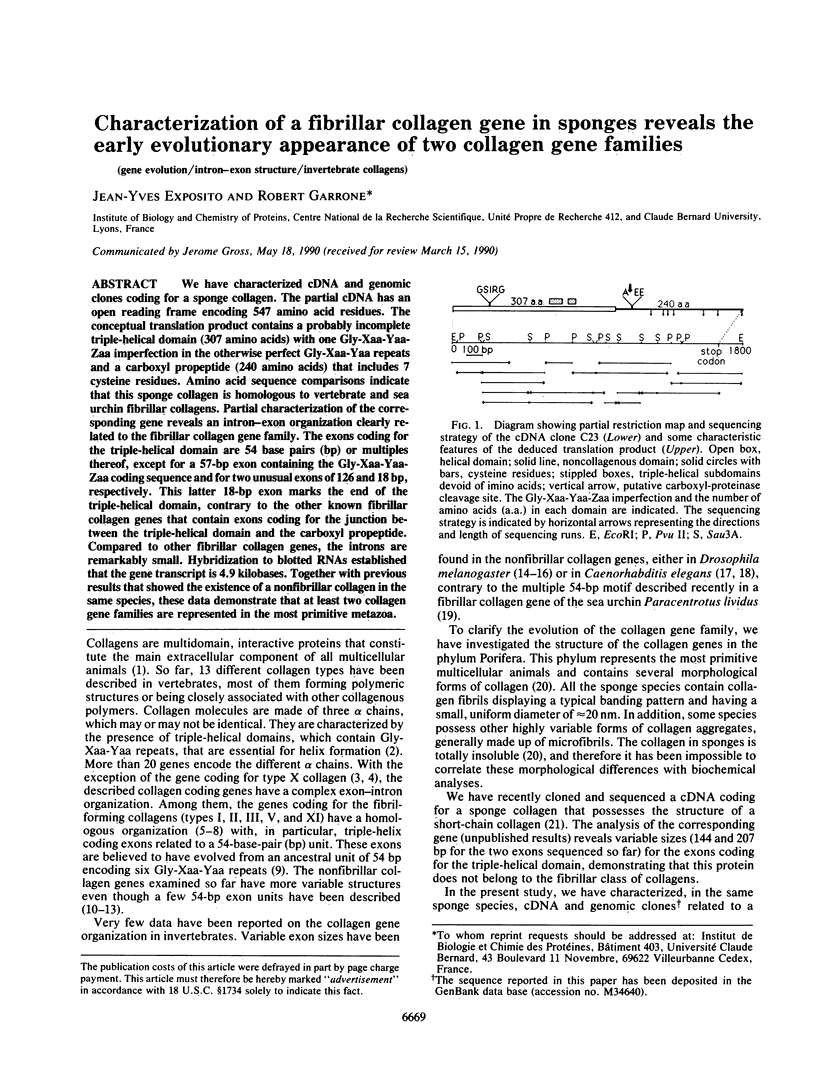
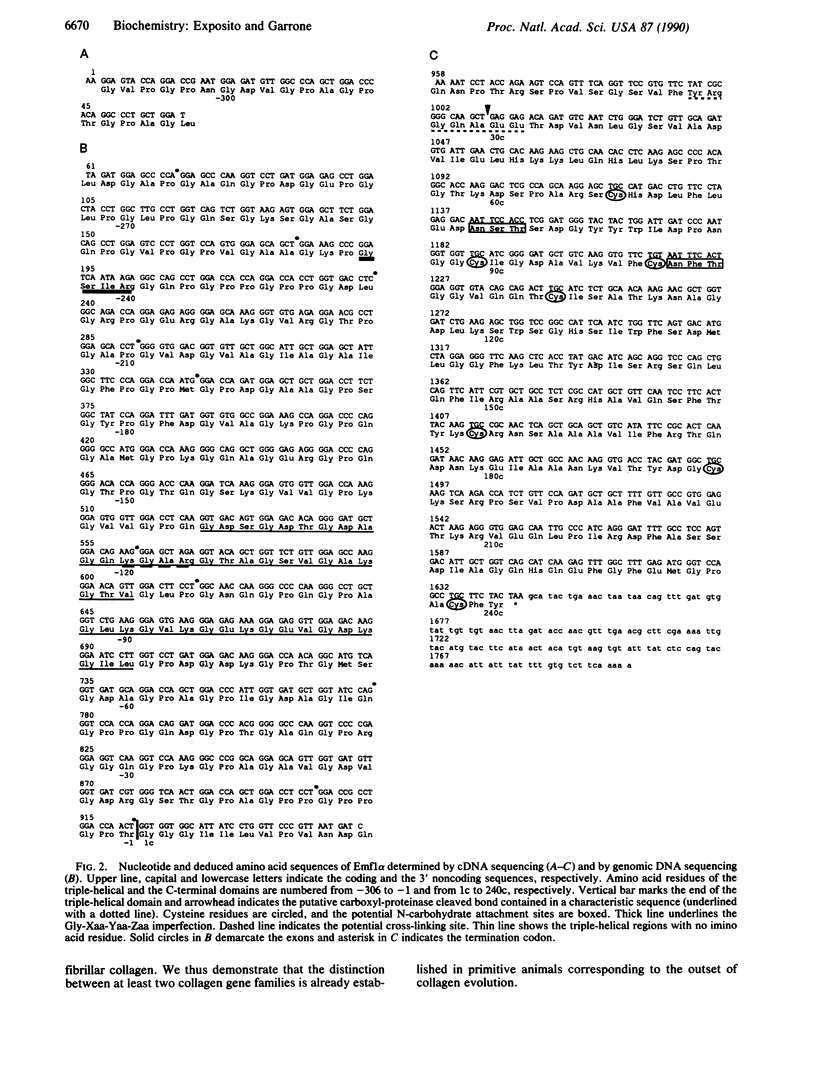
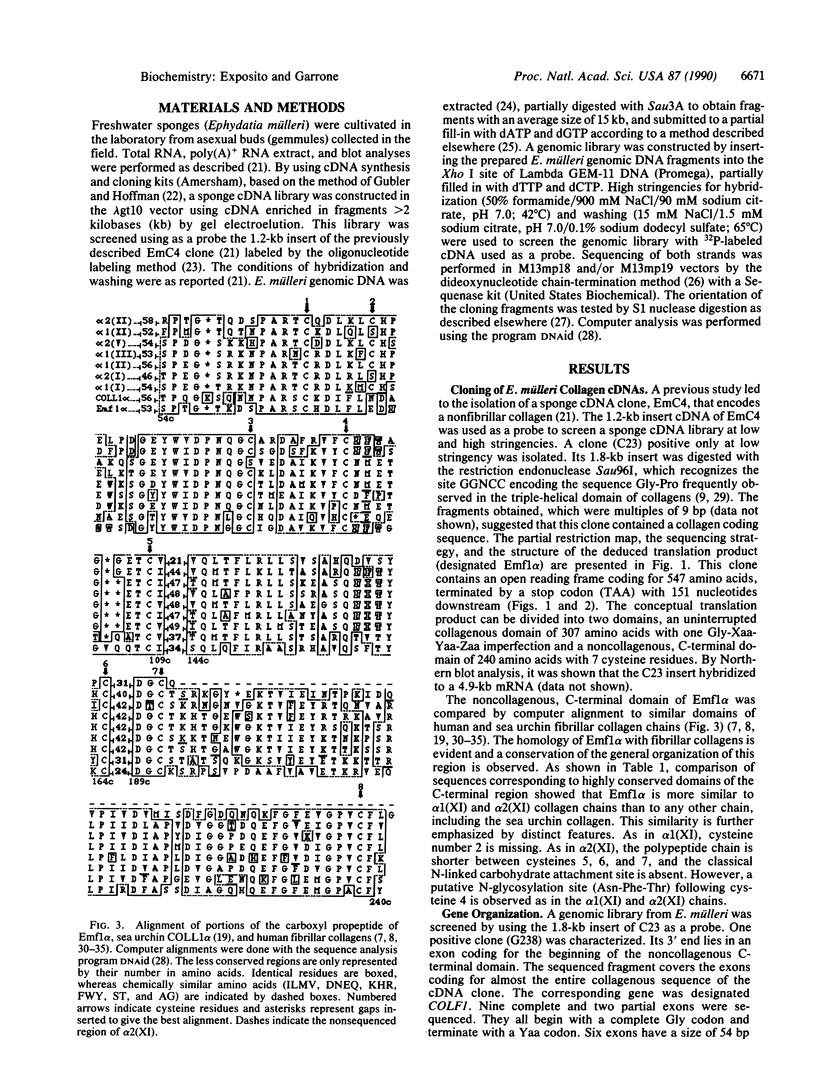
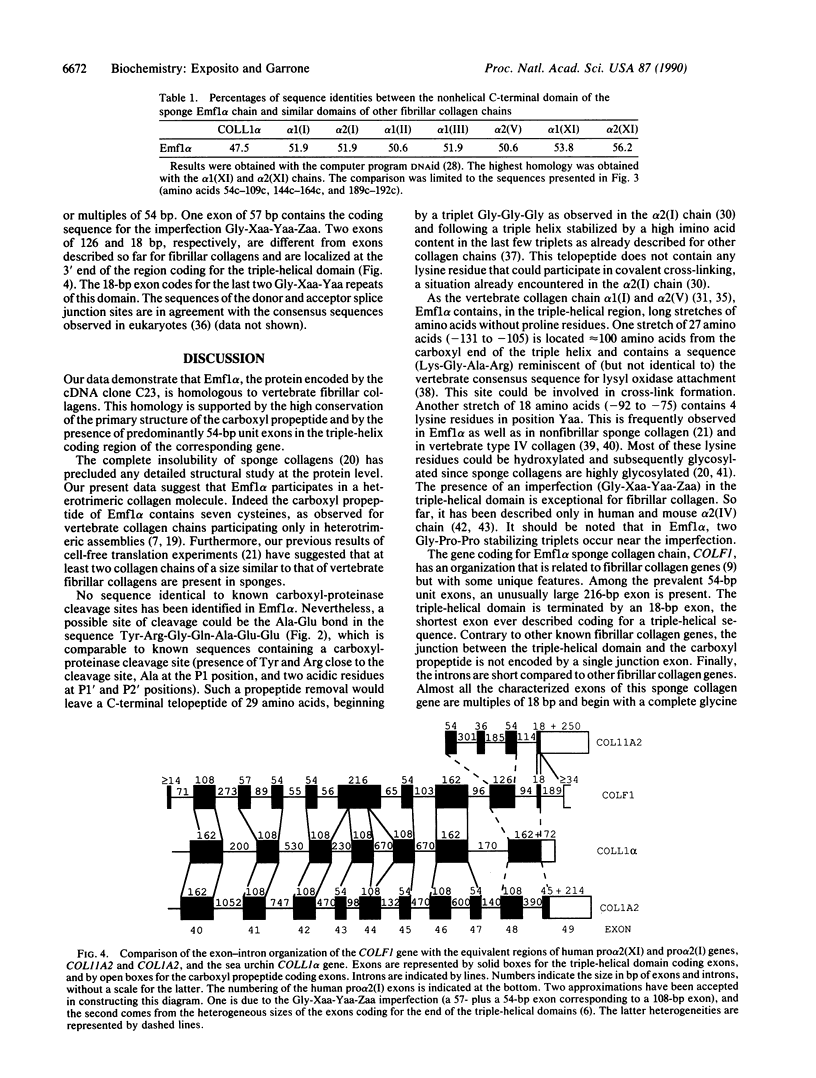
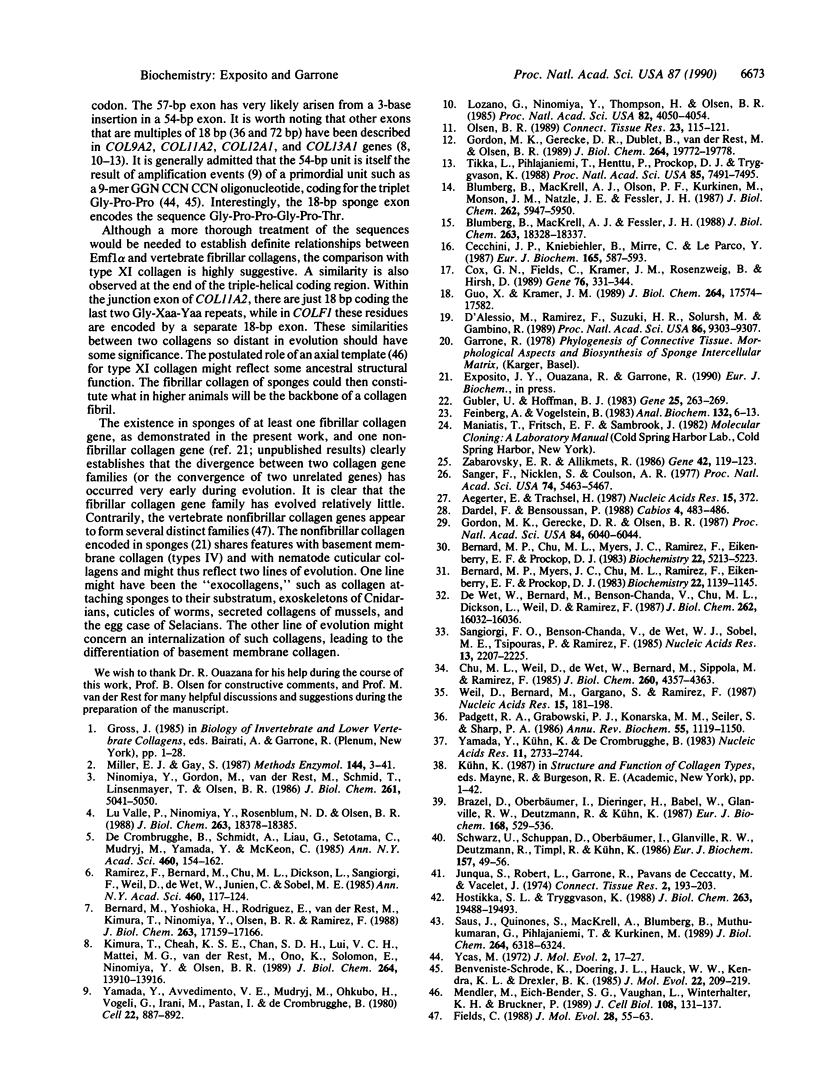
Selected References
These references are in PubMed. This may not be the complete list of references from this article.
- Aegerter E., Trachsel H. Determination of size and orientation of DNA fragments cloned in phage M13 by S1 nuclease mapping. Nucleic Acids Res. 1987 Jan 12;15(1):372–372. doi: 10.1093/nar/15.1.372. [DOI] [PMC free article] [PubMed] [Google Scholar]
- Benveniste-Schrode K., Doering J. L., Hauck W. W., Schrode J., Kendra K. L., Drexler B. K. Evolution of chick type I procollagen genes. J Mol Evol. 1985;22(3):209–219. doi: 10.1007/BF02099750. [DOI] [PubMed] [Google Scholar]
- Bernard M. P., Chu M. L., Myers J. C., Ramirez F., Eikenberry E. F., Prockop D. J. Nucleotide sequences of complementary deoxyribonucleic acids for the pro alpha 1 chain of human type I procollagen. Statistical evaluation of structures that are conserved during evolution. Biochemistry. 1983 Oct 25;22(22):5213–5223. doi: 10.1021/bi00291a023. [DOI] [PubMed] [Google Scholar]
- Bernard M. P., Myers J. C., Chu M. L., Ramirez F., Eikenberry E. F., Prockop D. J. Structure of a cDNA for the pro alpha 2 chain of human type I procollagen. Comparison with chick cDNA for pro alpha 2(I) identifies structurally conserved features of the protein and the gene. Biochemistry. 1983 Mar 1;22(5):1139–1145. doi: 10.1021/bi00274a023. [DOI] [PubMed] [Google Scholar]
- Bernard M., Yoshioka H., Rodriguez E., Van der Rest M., Kimura T., Ninomiya Y., Olsen B. R., Ramirez F. Cloning and sequencing of pro-alpha 1 (XI) collagen cDNA demonstrates that type XI belongs to the fibrillar class of collagens and reveals that the expression of the gene is not restricted to cartilagenous tissue. J Biol Chem. 1988 Nov 15;263(32):17159–17166. [PubMed] [Google Scholar]
- Blumberg B., MacKrell A. J., Fessler J. H. Drosophila basement membrane procollagen alpha 1(IV). II. Complete cDNA sequence, genomic structure, and general implications for supramolecular assemblies. J Biol Chem. 1988 Dec 5;263(34):18328–18337. [PubMed] [Google Scholar]
- Blumberg B., MacKrell A. J., Olson P. F., Kurkinen M., Monson J. M., Natzle J. E., Fessler J. H. Basement membrane procollagen IV and its specialized carboxyl domain are conserved in Drosophila, mouse, and human. J Biol Chem. 1987 May 5;262(13):5947–5950. [PubMed] [Google Scholar]
- Brazel D., Oberbäumer I., Dieringer H., Babel W., Glanville R. W., Deutzmann R., Kühn K. Completion of the amino acid sequence of the alpha 1 chain of human basement membrane collagen (type IV) reveals 21 non-triplet interruptions located within the collagenous domain. Eur J Biochem. 1987 Nov 2;168(3):529–536. doi: 10.1111/j.1432-1033.1987.tb13450.x. [DOI] [PubMed] [Google Scholar]
- Cecchini J. P., Knibiehler B., Mirre C., Le Parco Y. Evidence for a type-IV-related collagen in Drosophila melanogaster. Evolutionary constancy of the carboxyl-terminal noncollagenous domain. Eur J Biochem. 1987 Jun 15;165(3):587–593. doi: 10.1111/j.1432-1033.1987.tb11480.x. [DOI] [PubMed] [Google Scholar]
- Chu M. L., Weil D., de Wet W., Bernard M., Sippola M., Ramirez F. Isolation of cDNA and genomic clones encoding human pro-alpha 1 (III) collagen. Partial characterization of the 3' end region of the gene. J Biol Chem. 1985 Apr 10;260(7):4357–4363. [PubMed] [Google Scholar]
- Cox G. N., Fields C., Kramer J. M., Rosenzweig B., Hirsh D. Sequence comparisons of developmentally regulated collagen genes of Caenorhabditis elegans. Gene. 1989;76(2):331–344. doi: 10.1016/0378-1119(89)90173-x. [DOI] [PubMed] [Google Scholar]
- D'Alessio M., Ramirez F., Suzuki H. R., Solursh M., Gambino R. Structure and developmental expression of a sea urchin fibrillar collagen gene. Proc Natl Acad Sci U S A. 1989 Dec;86(23):9303–9307. doi: 10.1073/pnas.86.23.9303. [DOI] [PMC free article] [PubMed] [Google Scholar]
- Dardel F., Bensoussan P. DNAid: a Macintosh full screen editor featuring a built-in regular expression interpreter for the search of specific patterns in biological sequences using finite state automata. Comput Appl Biosci. 1988 Nov;4(4):483–486. doi: 10.1093/bioinformatics/4.4.483. [DOI] [PubMed] [Google Scholar]
- Feinberg A. P., Vogelstein B. A technique for radiolabeling DNA restriction endonuclease fragments to high specific activity. Anal Biochem. 1983 Jul 1;132(1):6–13. doi: 10.1016/0003-2697(83)90418-9. [DOI] [PubMed] [Google Scholar]
- Fields C. Domain organization and intron positions in Caenorhabditis elegans collagen genes: the 54-bp module hypothesis revisited. J Mol Evol. 1988 Dec;28(1-2):55–63. doi: 10.1007/BF02143497. [DOI] [PubMed] [Google Scholar]
- Gordon M. K., Gerecke D. R., Dublet B., van der Rest M., Olsen B. R. Type XII collagen. A large multidomain molecule with partial homology to type IX collagen. J Biol Chem. 1989 Nov 25;264(33):19772–19778. [PubMed] [Google Scholar]
- Gordon M. K., Gerecke D. R., Olsen B. R. Type XII collagen: distinct extracellular matrix component discovered by cDNA cloning. Proc Natl Acad Sci U S A. 1987 Sep;84(17):6040–6044. doi: 10.1073/pnas.84.17.6040. [DOI] [PMC free article] [PubMed] [Google Scholar]
- Gubler U., Hoffman B. J. A simple and very efficient method for generating cDNA libraries. Gene. 1983 Nov;25(2-3):263–269. doi: 10.1016/0378-1119(83)90230-5. [DOI] [PubMed] [Google Scholar]
- Guo X. D., Kramer J. M. The two Caenorhabditis elegans basement membrane (type IV) collagen genes are located on separate chromosomes. J Biol Chem. 1989 Oct 15;264(29):17574–17582. [PubMed] [Google Scholar]
- Hostikka S. L., Tryggvason K. The complete primary structure of the alpha 2 chain of human type IV collagen and comparison with the alpha 1(IV) chain. J Biol Chem. 1988 Dec 25;263(36):19488–19493. [PubMed] [Google Scholar]
- Junqua S., Robert L., Garrone R., Pavans de Ceccatty M., Vacelet J. Biochemical and morphological studies on collagens of horny sponges. Ircinia filaments compared to spongines. Connect Tissue Res. 1974;2(3):193–203. doi: 10.3109/03008207409152244. [DOI] [PubMed] [Google Scholar]
- Kimura T., Cheah K. S., Chan S. D., Lui V. C., Mattei M. G., van der Rest M., Ono K., Solomon E., Ninomiya Y., Olsen B. R. The human alpha 2(XI) collagen (COL11A2) chain. Molecular cloning of cDNA and genomic DNA reveals characteristics of a fibrillar collagen with differences in genomic organization. J Biol Chem. 1989 Aug 15;264(23):13910–13916. [PubMed] [Google Scholar]
- Lozano G., Ninomiya Y., Thompson H., Olsen B. R. A distinct class of vertebrate collagen genes encodes chicken type IX collagen polypeptides. Proc Natl Acad Sci U S A. 1985 Jun;82(12):4050–4054. doi: 10.1073/pnas.82.12.4050. [DOI] [PMC free article] [PubMed] [Google Scholar]
- LuValle P., Ninomiya Y., Rosenblum N. D., Olsen B. R. The type X collagen gene. Intron sequences split the 5'-untranslated region and separate the coding regions for the non-collagenous amino-terminal and triple-helical domains. J Biol Chem. 1988 Dec 5;263(34):18378–18385. [PubMed] [Google Scholar]
- Miller E. J., Gay S. The collagens: an overview and update. Methods Enzymol. 1987;144:3–41. doi: 10.1016/0076-6879(87)44170-0. [DOI] [PubMed] [Google Scholar]
- Ninomiya Y., Gordon M., van der Rest M., Schmid T., Linsenmayer T., Olsen B. R. The developmentally regulated type X collagen gene contains a long open reading frame without introns. J Biol Chem. 1986 Apr 15;261(11):5041–5050. [PubMed] [Google Scholar]
- Olsen B. R. The next frontier: molecular biology of extracellular matrix. Connect Tissue Res. 1989;23(2-3):115–121. doi: 10.3109/03008208909002411. [DOI] [PubMed] [Google Scholar]
- Padgett R. A., Grabowski P. J., Konarska M. M., Seiler S., Sharp P. A. Splicing of messenger RNA precursors. Annu Rev Biochem. 1986;55:1119–1150. doi: 10.1146/annurev.bi.55.070186.005351. [DOI] [PubMed] [Google Scholar]
- Ramirez F., Bernard M., Chu M. L., Dickson L., Sangiorgi F., Weil D., De Wet W., Junien C., Sobel M. Isolation and characterization of the human fibrillar collagen genes. Ann N Y Acad Sci. 1985;460:117–129. doi: 10.1111/j.1749-6632.1985.tb51160.x. [DOI] [PubMed] [Google Scholar]
- Sanger F., Nicklen S., Coulson A. R. DNA sequencing with chain-terminating inhibitors. Proc Natl Acad Sci U S A. 1977 Dec;74(12):5463–5467. doi: 10.1073/pnas.74.12.5463. [DOI] [PMC free article] [PubMed] [Google Scholar]
- Sangiorgi F. O., Benson-Chanda V., de Wet W. J., Sobel M. E., Tsipouras P., Ramirez F. Isolation and partial characterization of the entire human pro alpha 1(II) collagen gene. Nucleic Acids Res. 1985 Apr 11;13(7):2207–2225. doi: 10.1093/nar/13.7.2207. [DOI] [PMC free article] [PubMed] [Google Scholar]
- Saus J., Quinones S., MacKrell A., Blumberg B., Muthukumaran G., Pihlajaniemi T., Kurkinen M. The complete primary structure of mouse alpha 2(IV) collagen. Alignment with mouse alpha 1(IV) collagen. J Biol Chem. 1989 Apr 15;264(11):6318–6324. [PubMed] [Google Scholar]
- Schwarz U., Schuppan D., Oberbäumer I., Glanville R. W., Deutzmann R., Timpl R., Kühn K. Structure of mouse type IV collagen. Amino-acid sequence of the C-terminal 511-residue-long triple-helical segment of the alpha 2(IV) chain and its comparison with the alpha 1(IV) chain. Eur J Biochem. 1986 May 15;157(1):49–56. doi: 10.1111/j.1432-1033.1986.tb09636.x. [DOI] [PubMed] [Google Scholar]
- Tikka L., Pihlajaniemi T., Henttu P., Prockop D. J., Tryggvason K. Gene structure for the alpha 1 chain of a human short-chain collagen (type XIII) with alternatively spliced transcripts and translation termination codon at the 5' end of the last exon. Proc Natl Acad Sci U S A. 1988 Oct;85(20):7491–7495. doi: 10.1073/pnas.85.20.7491. [DOI] [PMC free article] [PubMed] [Google Scholar]
- Weil D., Bernard M., Gargano S., Ramirez F. The pro alpha 2(V) collagen gene is evolutionarily related to the major fibrillar-forming collagens. Nucleic Acids Res. 1987 Jan 12;15(1):181–198. doi: 10.1093/nar/15.1.181. [DOI] [PMC free article] [PubMed] [Google Scholar]
- Yamada Y., Avvedimento V. E., Mudryj M., Ohkubo H., Vogeli G., Irani M., Pastan I., de Crombrugghe B. The collagen gene: evidence for its evolutinary assembly by amplification of a DNA segment containing an exon of 54 bp. Cell. 1980 Dec;22(3):887–892. doi: 10.1016/0092-8674(80)90565-6. [DOI] [PubMed] [Google Scholar]
- Yamada Y., Kühn K., de Crombrugghe B. A conserved nucleotide sequence, coding for a segment of the C-propeptide, is found at the same location in different collagen genes. Nucleic Acids Res. 1983 May 11;11(9):2733–2744. doi: 10.1093/nar/11.9.2733. [DOI] [PMC free article] [PubMed] [Google Scholar]
- Ycas M. De novo origin of periodic proteins. J Mol Evol. 1972 Dec 29;2(1):17–27. doi: 10.1007/BF01653939. [DOI] [PubMed] [Google Scholar]
- Zabarovsky E. R., Allikmets R. L. An improved technique for the efficient construction of gene libraries by partial filling-in of cohesive ends. Gene. 1986;42(1):119–123. doi: 10.1016/0378-1119(86)90158-7. [DOI] [PubMed] [Google Scholar]
- de Crombrugghe B., Schmidt A., Liau G., Setoyama C., Mudryj M., Yamada Y., McKeon C. Structural and functional analysis of the genes for alpha 2(I) and alpha 1(III) collagens. Ann N Y Acad Sci. 1985;460:154–162. doi: 10.1111/j.1749-6632.1985.tb51163.x. [DOI] [PubMed] [Google Scholar]
- de Wet W., Bernard M., Benson-Chanda V., Chu M. L., Dickson L., Weil D., Ramirez F. Organization of the human pro-alpha 2(I) collagen gene. J Biol Chem. 1987 Nov 25;262(33):16032–16036. [PubMed] [Google Scholar]


